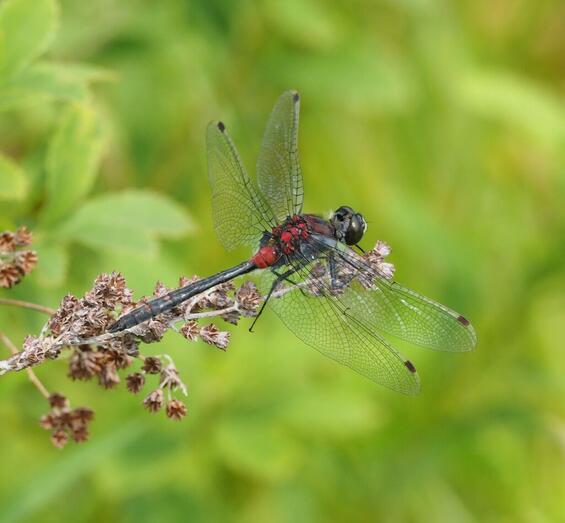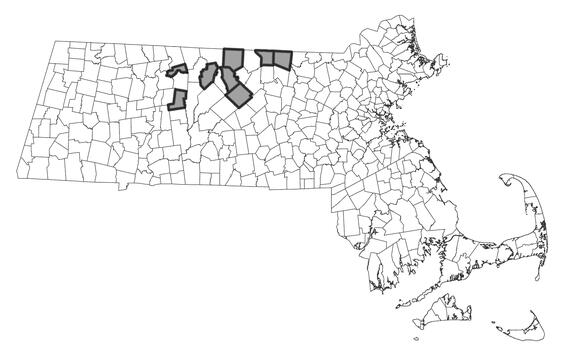- Scientific name: Leucorrhinia glacialis
Species of Greatest Conservation Need (MA State Wildlife Action Plan)
Description

Male crimson-ringed whiteface
The crimson-ringed whiteface is a small, slender insect belonging to the order Odonata, suborder Anisoptera (the dragonflies), and family Libellulidae (the skimmers), the largest dragonfly family in North America. The species belongs to the genus Leucorrhinia (the whitefaces) characterized by their white face, dark eyes, basal hindwing dark patch, and dark thorax and abdomen marked with red or yellow marks. For the crimson-ringed whiteface, immatures possess yellow blotches on the thorax and becomes bright red in mature males and some females. Male abdomens are almost all black except for red marks on segments two and three. Females possess yellow dorsal marks on segments two through seven. Both sexes have all black labiums.
Adults crimson-ringed whitefaces range from 34-35 mm (1.3-1.4 in) in length. Fully developed nymphs and exuviae may range from 16-19 mm (~0.7 in).
Four other species of whitefaces occur in Massachusetts and are most similar in appearance to crimson-ringed whiteface. Identification can be difficult amongst these species, but mature male crimson-ringed whiteface is distinguished by their red thorax and all black abdomens. Females are almost identical to other Leucorrhinia except for a few features. These female characters along with others to distinguish males can be found in Paulson (2011) and Lam (2024). For nymph identification refer to keys in Tennessen (2019).
Life cycle and behavior

Note, nymphs may be present year-round.
The egg and nymph life stages of the crimson-ringed whiteface are fully aquatic. The cryptic nymphs are predators likely feeding on smaller invertebrates. Nymphs undergo several molts (instars) for at least 1 year until they are ready to emerge as winged adults. Nymphs emerge up onto emergent vegetation or other substrate primarily in late May. When the nymph reaches a secure substrate, the adult begins to push itself out of the exoskeleton. As soon as the abdomen and wings are fully expanded, the adult takes its first flight. This maiden flight usually carries the individuals up into surrounding forest or other areas away from wetlands, where they spend several days maturing and feeding and are somewhat protected from predation and inclement weather. Adult males defend territories from other males and perch flat on floating leaves, riparian shrubs, and the ground. Females occupy surrounding forested uplands. Like all dragonflies, crimson-ringed whitefaces are predators feeding on small insects.
Breeding in Massachusetts probably occurs in June and July. Mating may take up 30 minutes. Following mating, the female oviposits eggs by intermittently tapping the surface of water, while the male hovers nearby.
Crimson-ringed whitefaces emerge in late May and are on the wing until early August. Height of adult activity is likely in June.
Distribution and abundance
Crimson-ringed whiteface is a widespread species with a northernly North America distribution. The species range extends from West Virginia, northeast through the Canadian Maritime provinces, west through Canada and south to California. The species occurs in all New England state. In Massachusetts, the species occurs in the Middle Connecticut, Millers, Chicopee, and Nashua River watersheds typically close to watershed lines on the north-central portion of the state. The species has been documented at <10 sites typically at low to moderate abundances (<50 individuals). The species status remains uncertain in Massachusetts.

Distribution in Massachusetts.
1999-2024
Based on records in iNaturalist, Odonata Central, and Natural Heritage databases.
Habitat
Crimson-ringed whiteface inhabits ponds and lakes with floating-leaved aquatic vegetation and boggy margins dominated by sphagnum. Ponds without fish might be more suitable. Nymphs inhabit muddy substrates amongst organic matter. The adults also inhabit the surrounding forested uplands.
Healthy habitats are vital for supporting native wildlife and plants. Explore habitats and learn about conservation and restoration in Massachusetts.
Small pond with extensive boggy margins dominated by sphagnum.
Threats
The primary threat to crimson-ringed whiteface is wetland, riparian, and upland habitat destruction through physical alteration or pollution. In some portions of its range, species habitat is under pressure from development, logging, peat mining, and resulting sedimentation. Permanent changes in water level from anthropogenic or beaver sources, invasive aquatic plant species, and various forms of pollution, such as road and agricultural runoff, septic system failure, and insecticides, are also potential threats. Climate change is likely a threat to this species given Massachusetts lies near its southernly range edge and the species inhabits peatland habitats.
Conservation
Survey and monitoring
Standardized and targeted surveys for crimson-ringed whiteface is needed to determine its status in Massachusetts. Surveys should target historical and new wetland sites to determine species occupancy and population status. Surveys for adults are likely to be more effective for detection compared to nymph or exuviae surveys because of their small size and difficult to sample habitat. Adult surveys should target bog and fen habitats during their flight period at standardized weather and time windows to maximize species detection. Multiple site visits (e.g., ≥3) may be required to detect this species. Routine monitoring of prioritized sites is needed estimate occupancy trends overtime.
Management
Protection and restoration of wetlands and its surrounding upland habitat is crucial for crimson-ringed whiteface persistence in Massachusetts. Upland habitats adjoining the breeding sites should be maintained for roosting, hunting, and for newly emerged adults that are more susceptible to mortality from predation and inclement weather. Development of these areas should be discouraged, and the preservation of remaining undeveloped uplands should be a priority. Alternatives to commonly applied road salts should be tested to minimize freshwater salinization. Other actions to improve or prevent habitat degradation include reduction of nutrient, agricultural and road runoff; minimization of water level alteration and groundwater withdrawals; prevention and management of nonnative aquatic vegetation species; limitation and enforcement of off-road vehicles in wetland habitat; and connection between wetlands.
Research needs
Through standardized surveys, effort is needed to define habitat requirements, distribution, relative abundance, and potential breeding sites in Massachusetts. Research effort is needed to estimate detection and occupancy rates and how other environmental variables (e.g., sample timing, weather) affect these rates. Other research efforts include projections of species distribution under climate change scenarios and climate vulnerability analysis in Massachusetts, since this species occupies bog habitats and is near its southernly edge range in the state.
References
Brown, V.A. 2020. Dragonflies and Damselflies of Rhode Island. Rhode Island Division of Fish and Wildlife, Department of Environmental Management, West Kingston RI.
Lam, E. Dragonflies of North America. Princeton NJ: Princeton University Press, 2024.
Nikula, B., J.L. Ryan, and M.R. Burne. A Field Guide to the Dragonflies and Damselflies of Massachusetts. 2nd ed. Massachusetts Natural Heritage and Endangered Species Program, 2007.
Paulson, D. Dragonflies and Damselflies of the East. Princeton NJ: Princeton University Press, 2011.
Tennessen, K. Dragonfly Nymphs of North America: An identification guide. Springer, 2019.
Contact
| Date published: | April 8, 2025 |
|---|